The Skei burial field is located at the farm Skei, in Sparbu in Trøndelag. Skei is the largest prehistoric burial field in the Northern parts of Trøndelag with around 120 visible graves of different shapes and sizes. Most of the mounds are either round or elongated mounds. The elongated mounds seems to most often be graves of woman. There are also a few mounds shaped like a three-pointed star or the letter Y, a so called Y-shaped mound. Y-shaped mounds seems to be from the Late Iron Age.
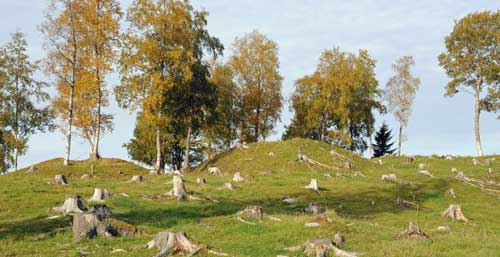
Photo by Morten Stene, borrowed from Steinkjerleksikonet.
It seems that the burial field was mainly in use in the Late Iron Age, but there is evidence of previous use as well. The findings made are mainly from the Merovingian period and the Viking age. What they have found in the burials are rich and rare finds, especially the objects they found in one of the Y-shaped mound. Here, a female skeletal grave was found in a coffin with, among other things, three objects from Ireland: a hanging bronze lamp, a bronze handle and a bucket made of yew with gilded bronze fittings and a handle with inlaid silver. In addition, there was a squared brooch from England, beads, harness with bronze fittings, textiles and much more in the grave. This was clearly a lady with high social status and rank.
Along with the burials, a system of houses, called a ring yard, was also identified. The ring yard is located right in the center of the burial field. There may have been as many as eight houses in this ring yard, but this number is a bit uncertain.

Picture borrowed from Steinkjer kunnskapsportal. Here you can see the different burials, and the ring yard.
In the area around the ring yard, many cooking pits have been found, which testifies that food has been cooked for many people here. At Heggstad in Verdal and at Værem in Grong, ring yards have also been found, but otherwise most such facilities have been found along the coast of Norway. In southwestern Norway, ring yards seems to have fallen out of use before 400, while some ring yards appear to have been used until the 10th century in northern Norway.
What function did the houses have? One explanation may be that they were used as barracks for the soldiers of a local chief and that the houses are placed in a circle to facilitate the defense of the camp. The location of the ring yard at an intersection may also have had strategic reasons.
A recent theory is that the houses have been used as accommodation in connection with the Thing (assembly). People traveling from afar could stay overnight here and then travel the last part, well rested for the Thing. From the burial field to Logtun, the place where Frostatinget was held, it only takes 4 hours and 22 minutes with a bicycle, so riding a horse or even walking from Skei to Logtun wasn’t too long of a trip.
The number of houses has varied from the different ring yards around Norway, but the amount of houses seems to correspond with the number of districts in the relevant areas.
The name Skei are believed to mean skille in Norwegian. It is a bit hard to explain the word in English, but et skille can be for example a division, a separation or a distinction. Most likely, the word comes from the fact that there was a crossroads on the site. Archaeologists has examined other farms called Skei elsewhere and found that all are located at ancient crossroads. There are 7 farms called Skei in Nord-Trøndelag.
Of the around 120 graves, I want to show you one special one. It’s grave mound number 40. It is a woman’s grave and a lot of interesting and beautiful objects were found there. I want to show you some of the objects. This woman was buried in a boat shaped mound sometimes during the Viking age. The mound was 14,5 meters long and 4,5 meters wide. When they opened the grave to examine it, they found a rectangular shaped cist. The cist was oriented in the same direction as the mound itself. They also found nails and wood fragments, which indicates an inner wooden coffin. During the excavation they found over 100 objects of archaeological interest. Let’s take a closer look at some of them.
The most exciting and special find is perhaps a triangular shaped hanging vessel made of bronze. Inside, in one of the corners, there is a semicircular strainer.

Hanging vessel made of bronze (T20913:1)
Photo by Ole Bjørn Pedersen, NTNU Vitenskapsmuseet, CC BY-SA 4.0

Bailer made of bronze (T20913:2)
Photo by Ole Bjørn Pedersen, NTNU Vitenskapsmuseet, CC BY-SA 4.0
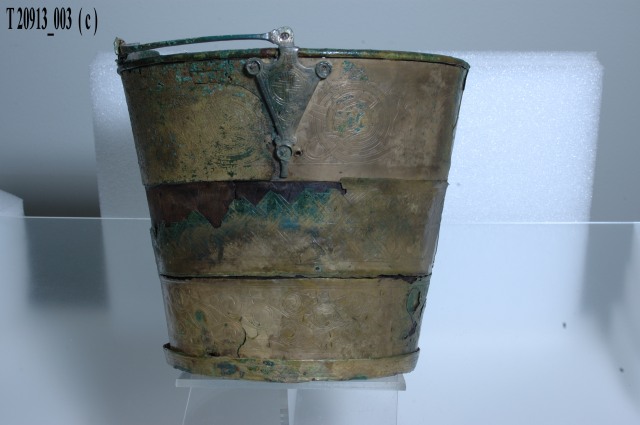
Pail made of bronze, iron, tin and wood (T20913:3)
Photo by Ole Bjørn Pedersen, NTNU Vitenskapsmuseet, CC BY-SA 4.0
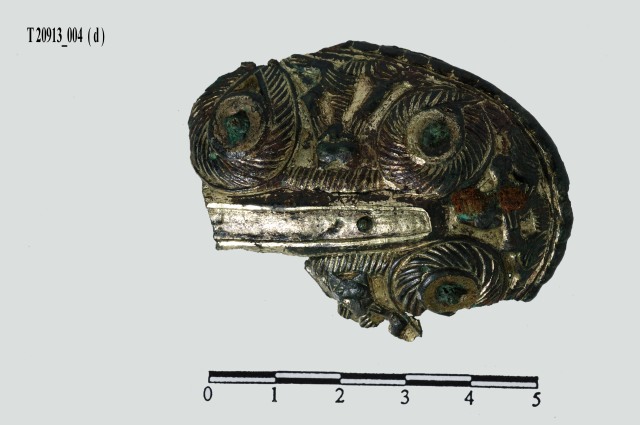
Oval brooch made of bronze (T20913:4)
Photo by Ole Bjørn Pedersen, NTNU Vitenskapsmuseet, CC BY-SA 4.0
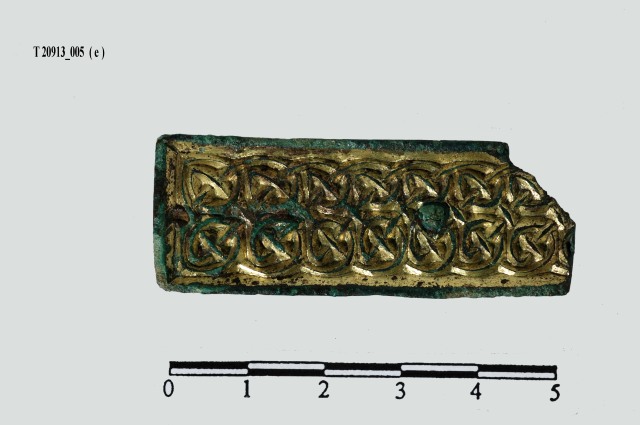
Rectangular shaped jewelery made of bronze (T20913:5)
Photo by Ole Bjørn Pedersen, NTNU Vitenskapsmuseet, CC BY-SA 4.0

Bead made of glass (T20913:8)
Photo by Ole Bjørn Pedersen, NTNU Vitenskapsmuseet, CC BY-SA 4.0

Bead made of glass (T20913:10)
Photo by Ole Bjørn Pedersen, NTNU Vitenskapsmuseet, CC BY-SA 4.0
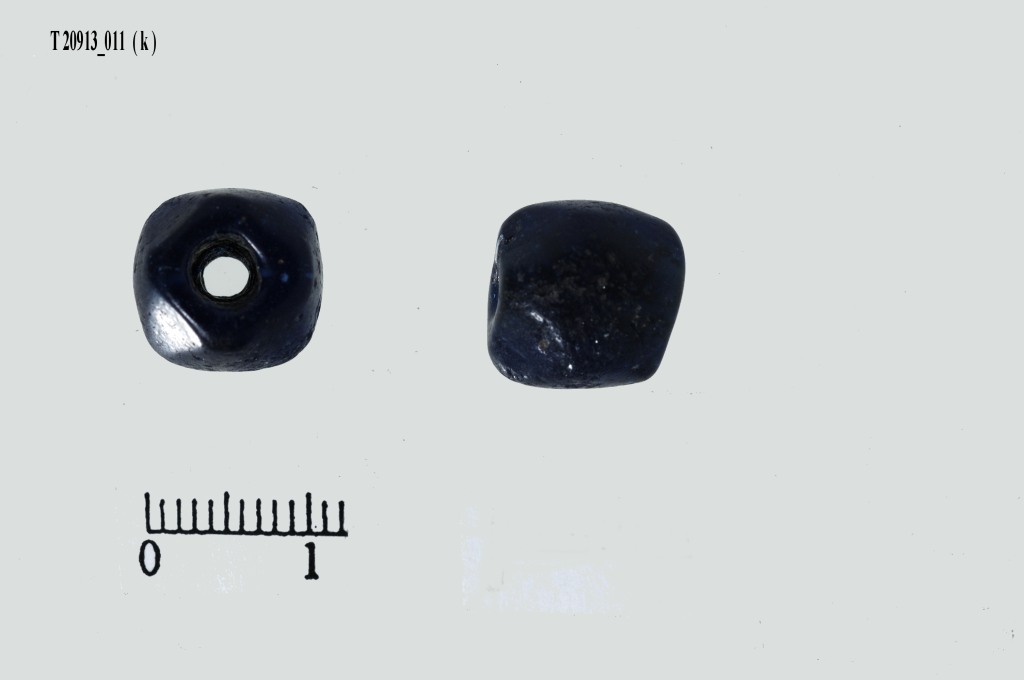
Bead made of glass (T20913:11)
Photo by Ole Bjørn Pedersen, NTNU Vitenskapsmuseet, CC BY-SA 4.0

Bead made of amber (T20913:13)
Photo by Ole Bjørn Pedersen, NTNU Vitenskapsmuseet, CC BY-SA 4.0

Bead made of amber (T20913:14)
Photo by Ole Bjørn Pedersen, NTNU Vitenskapsmuseet, CC BY-SA 4.0

Plate made of whalebone (T20913:15)
Photo by Ole Bjørn Pedersen, NTNU Vitenskapsmuseet, CC BY-SA 4.0
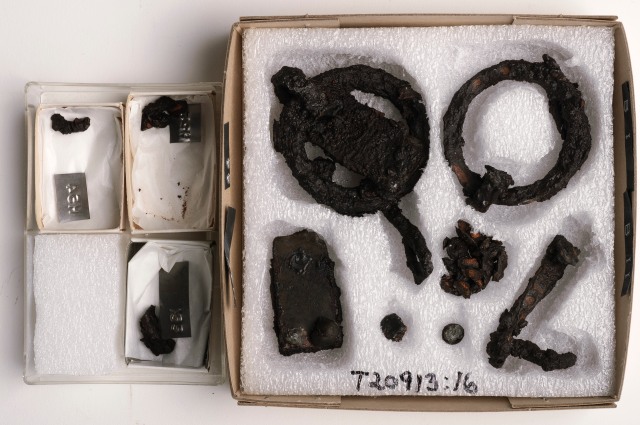
Harness made of iron (T20913:16)
Photo by Ole Bjørn Pedersen, NTNU Vitenskapsmuseet, CC BY-SA 4.0

Fragment of textile (T20913:40)
Photo by Ole Bjørn Pedersen, NTNU Vitenskapsmuseet, CC BY-SA 4.0
If you are interested in seeing more finds from this burial mound, you can find all of them here.
Information:
Store norske leksikon – Skeifeltet
Eggevandring
Steinkjerleksikonet
NTNU – Arkeologisk rapport

Thank you for posting this article.
I first saw this site featured on a tv show called What On Earth? and I’ve been enamoured with the site, this area of Norway and it’s history ever since.
LikeLiked by 1 person
Thank you for your comment! Oh wow, I didn’t know that ‘What on Earth’ included this site on the show. That’s very cool! You’re absolutely right. It is a very interesting and impressive site. The whole area of Trøndelag is so rich with finds from this period. I’m really lucky to be located right here 🙂 Hope you will enjoy more posts on my blog!
LikeLike
you’re most welcome. my current focus of history learning is of my ancestors who came from Halychyna (a historical region that’s now part of Poland, Slovakia, and Ukraine). I’ve always been fascinated in the roots of Scandinavia and will definitely follow your blog.
LikeLiked by 1 person